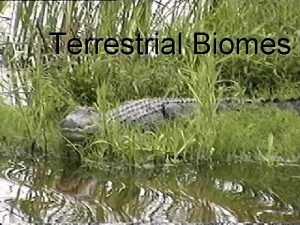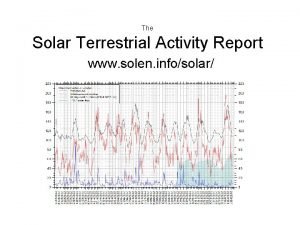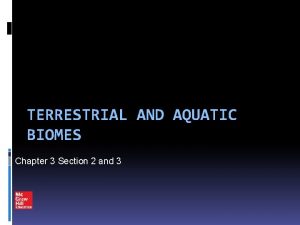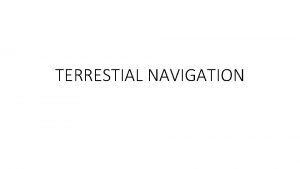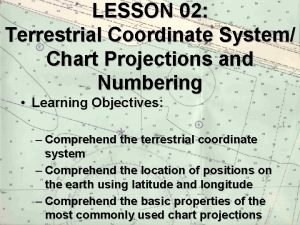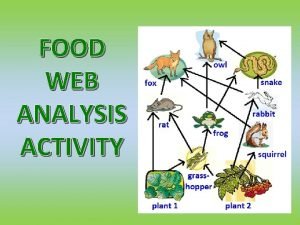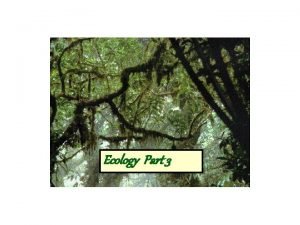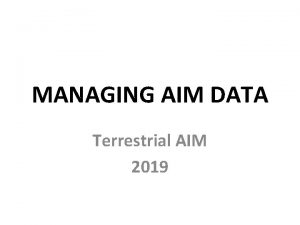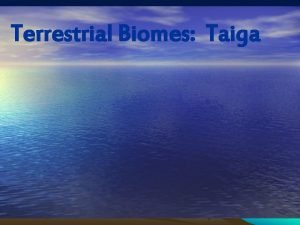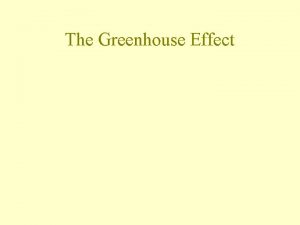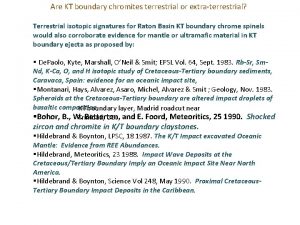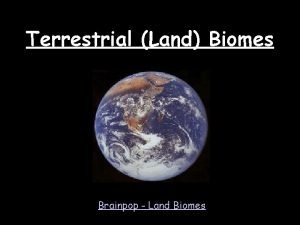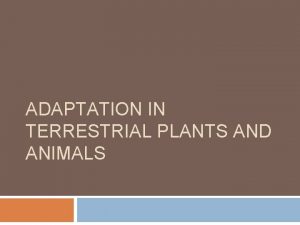Terrestrial AIM Examples Using 3 examples of terrestrial

















- Slides: 17

Terrestrial AIM Examples Using 3 examples of terrestrial AIM projects, we will discuss the following: • Monitoring goals/applications • How sites were selected? • What indicators were measured? • Initial results

National Scale: BLM Rangeland Resource Assessment BLM • Report on the status and condition of renewable resources on federal rangelands managed by the BLM and make available to the public Assessment, Inventory, and Monitoring (AIM) Strategy Monitoring goals and applications:

National Scale: BLM Rangeland Resource Assessment – Probability-based design ( 900 pts) • Target Population – BLM rangelands (lower 48) • Stratification – Level II, III, or combination of Level III EPA Ecoregions BLM • Sample Design Assessment, Inventory, and Monitoring (AIM) Strategy How were the sites selected?

National Scale: BLM Rangeland Resource Assessment – – Vegetation composition Non-native, invasive plant species Inter-canopy gaps Vegetation height Line-Point Intercept • Contingent Indicators – Soil aggregate stability • Supplemental Indicators – Interpreting Indicators of Rangeland Health BLM • Core Indicators Assessment, Inventory, and Monitoring (AIM) Strategy What were measured?

National Scale: BLM Rangeland Resource Assessment BLM Rangeland with at Least 30% Bare Ground Assessment, Inventory, and Monitoring (AIM) Strategy Initial Results:

National Scale: BLM Rangeland Resource Assessment BLM Rangeland where Soil Aggregate Stability is Ranked 4 or Less Assessment, Inventory, and Monitoring (AIM) Strategy Initial Results:

Regional Scale: LUP Effectiveness – E. g. veg goal: manage vegetation communities to restore, maintain, or enhance vegetation community health, composition, and diversity to benefit multiple resources and their uses – E. g. veg objective: native perennial grass cover remains above 20% after 10 years with 80% confidence – E. g. wildlife objective: sage grouse wintering habitat must have sagebrush cover within a 0. 53 mile (850 meter) buffer BLM • Establish quantitative, baseline conditions • Monitor and evaluate status of resources and effectiveness of management practices over time Assessment, Inventory, and Monitoring (AIM) Strategy Monitoring goals and applications:

Regional Scale: LUP Effectiveness BLM Assessment, Inventory, and Monitoring (AIM) Strategy How were the sites selected?

Regional Scale: LUP Effectiveness – Vegetation composition – Non-native, invasive plant species – Inter-canopy gaps – Vegetation height • Contingent Indicators – Soil aggregate stability • Supplemental Indicators – Indicators of Rangeland Health Soil Aggregate Stability BLM • Core Indicators Assessment, Inventory, and Monitoring (AIM) Strategy What were measured?

Regional Scale: LUP Effectiveness BLM Objective: >20% Assessment, Inventory, and Monitoring (AIM) Strategy Initial Results:

Regional Scale: LUP Effectiveness BLM Assessment, Inventory, and Monitoring (AIM) Strategy Initial Results:

Regional Scale: LUP Effectiveness BLM Assessment, Inventory, and Monitoring (AIM) Strategy Initial Results:

Regional Scale: Sage Grouse Habitat – E. g. , native perennial herbaceous plant cover on all sagebrush habitats remains above 15% after 10 years with 80% confidence BLM • Establish quantitative, baseline conditions • Maintain sage grouse habitat Assessment, Inventory, and Monitoring (AIM) Strategy Monitoring goals and applications:

Regional Scale: Sage Grouse Habitat – Probability-based design • Target Population – Sage grouse habitat • Stratification – Disturbance Response Groups (combination of similar ecological sites) BLM • Sample Design Assessment, Inventory, and Monitoring (AIM) Strategy How were the sites selected?

Regional Scale: Sage Grouse Habitat – – – Vegetation composition Non-native, invasive plant species Inter-canopy gaps Preferred forbs Vegetation height (sagebrush, perennial forbs/grasses) • Supplemental Indicators – Sagebrush shape BLM • Core Indicators Assessment, Inventory, and Monitoring (AIM) Strategy What were measured?

Regional Scale: Sage Grouse Habitat Objective: >15% 16 BLM Assessment, Inventory, and Monitoring (AIM) Strategy Initial Results:

BLM • Public lands are not islands • Consistent data collected using consistent methods can be used by various audiences with different objectives (as seen in examples) • AIM provides unbiased data – multiple scale questions and defensible data Assessment, Inventory, and Monitoring (AIM) Strategy Conclusion:
 Terrestrial biomes chart
Terrestrial biomes chart System.collections.generics
System.collections.generics Unit 25 special refrigeration system components
Unit 25 special refrigeration system components Terrestrial planets surface
Terrestrial planets surface Solar terrestrial activity report
Solar terrestrial activity report What are terrestrial planets made of
What are terrestrial planets made of Solar system inner and outer planets
Solar system inner and outer planets Chapter 3 section 2 terrestrial biomes
Chapter 3 section 2 terrestrial biomes Terrestrial navigation meaning
Terrestrial navigation meaning Terrestrial soil
Terrestrial soil Are plants multicellular
Are plants multicellular Terrestrial biomes definition
Terrestrial biomes definition Inner planets and outer planets
Inner planets and outer planets Gnomonic chart
Gnomonic chart Food web analysis worksheet
Food web analysis worksheet Food chain ladybug
Food chain ladybug Sequence of food chain
Sequence of food chain Human impact on terrestrial ecosystems
Human impact on terrestrial ecosystems
